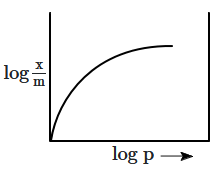A colloidal system having a solid substance as a dispersed phase and a liquid as a dispersion medium is classified as .........
1. Solid sol
2. Gel
3. Emulsion
4. Sol
The values of colligative properties of colloidal solution are of small order in comparison to those shown by true solutions of same concentration because of colloidal particles .........
1. Exhibit enormous surface area
2. Remain suspended in the dispersion medium
3. Form lyophilic colloid
4. Are comparatively less in number
Arrange the following diagrams in correct sequence of steps involved in the mechanism of catalysis, in accordance with modern adsorption theory.
1. IIIIIIIVV
2. IIIIIIIVV
3. IIIIIIVIV
4. IIIIIIVIV
The process responsible for the formation of delta at a place where rivers meet the sea is
1. Emulsification
2. Colloid formation
3. Coagulation
4. Peptisation
The correct curve for Freundlich's adsorption isotherm is:
| 1. |  |
2. |  |
| 3. |  |
4. |  |
Which of the following process is not responsible for the presence of electric charge on the sol particles?
1. Electron capture by sol particles
2. Adsorption of ionic species from solution
3. Formation of Helmholtz electrical double layer
4. Absorption of ionic species from solution
The phenomenon that is applicable to the process shown in the figure is :
1. Absorption
2. Adsorption
3. Coagulation
4. Emulsification
The correct statements among the following are:
| a. | Micelle formation by soap in an aqueous solution is possible at all temperatures |
| b. | Micelle formation by soap in an aqueous solution occurs above a particular concentration |
| 3. | On dilution of soap solution micelles may revert to individual ions |
| 4. | Soap solution behaves like a normal strong electrolyte at all concentrations |
1. (a, b)
2. (b, c)
3. (c, d)
4. (a, d)
The correct statements among the following about solid catalysts is -
| a. | Same reactants may give different products by using different catalysts |
| b. | Catalyst does not change ∆ H of reaction |
| c. | Catalyst is required in large quantities to catalyse reactions |
| d. | Catalytic activity of a solid catalyst does not depend upon the strength of chemisorption |
1. a and b
2. b and c
3. c and d
4. a and d
At the equilibrium position in the process of adsorption ..........
1. ΔH > 0
2. ΔH = TΔS
3. ΔH > TΔS
4. ΔH < TΔS








